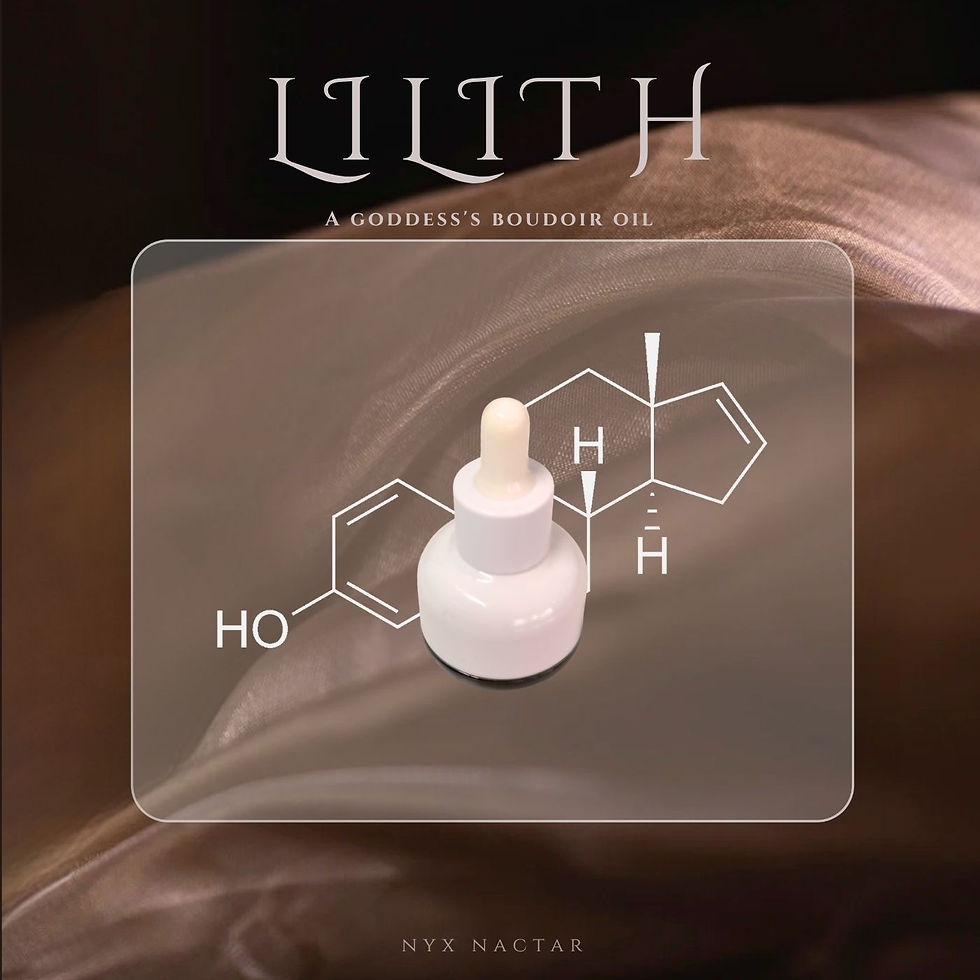The Pheromone Perfume VS Pheromone Oils: The Perfume is Dead? Why Pheromone Oils are the New Apex of Olfactory Science
- Nyx Alchemia

- Oct 8
- 7 min read
Forget everything you think you know about attraction. The age of diluted, alcohol-based "pheromone perfumes" is over. Welcome to the era of concentrated, skin-synergistic, neuro-alchemical oils. This is the difference between a whisper and a command.
In the sprawling, often deceptive marketplace of desire, two terms are frequently, and foolishly, used interchangeably: "Pheromone Perfume" and "Pheromone Oil". It's an understandable confusion, born from a market saturated with marketing claims but starved of real science.
This article is not a sales pitch. It is an education. It is the definitive guide to understanding the profound, chasm-like difference between a scented alcohol spray and a true, biologically active chemosignal matrix.
Let's deconstruct the alchemy.
The Fundamental Flaw of "Pheromone Perfume"
A "Pheromone Perfume" is, at its core, a traditional fragrance with a gimmick. It is a solution overwhelmingly composed of two things: alcohol (ethanol) and synthetic fragrance compounds. The "pheromones" advertised are often an afterthought, a sprinkle of unspecified, low-concentration molecules tossed into a volatile and hostile chemical environment.
The Problem of Volatility
A Scent that Screams, then Disappears. Alcohol is a solvent designed for one primary purpose: to evaporate quickly, creating a "cloud" of scent upon application. This creates an initial, powerful olfactory "hit"—the top notes of a fragrance.
However, this very volatility is the mortal enemy of complex pheromonal compounds. The rapid evaporation means:
Rapid Degradation: The delicate chemosignal molecules are carried away and dissipate into the air almost as quickly as they are applied. Their "hang time" in your personal space is minimal.
"Screaming" vs. "Whispering": A perfume announces your arrival. A true pheromonal signal should be a constant, low-frequency hum that operates on a subconscious level. Perfumes are simply too "loud" and fleeting to achieve this sophisticated biological conversation.
The Problem of Composition
A Chemical Soup.The complex bouquet of a traditional perfume can contain hundreds of different synthetic aroma-chemicals. These molecules compete for olfactory "real estate". When you introduce a pheromone into this chaotic soup, you are asking a subtle, biological whisper to compete with a shouting mob of synthetic noise. In most cases, the whisper is lost. The intended chemosignal is either masked, distorted, or simply ignored by the recipient's brain.
The Paradigm Shift: The Superiority of the "Pheromone Oil" Matrix
A true Pheromone Oil, like those engineered at NYX NECTAR, operates on a completely different scientific and philosophical principle. It is not a fragrance. It is a dermal delivery system for biologically active signals.
1. The Power of the Carrier: The Oil is the Anchor. Instead of volatile alcohol, our matrix is built upon a foundation of premium, skin-mimicking carrier oils (like Jojoba Oil). This is not just a base; it is a strategic choice.
Slow, Controlled Release: The oil traps and holds the precious chemosignal molecules. As your skin warms, the oil is slowly absorbed, releasing the pheromones in a steady, controlled "pulse" over many hours (our tests show 8-12 hours of peak efficacy). It doesn't scream; it endures. It becomes a part of your skin's unique signature.
Enhanced Durability & Projection: The oil creates a "second skin," a microscopic layer where the pheromones reside, projecting a stable, personal aura around you. It doesn't fill a room with scent; it creates an irresistible gravitational field that pulls others into your orbit.
Pheromone oil: The Purity of the Signal
The Message is Everything. In our formulations, the pheromones are not an afterthought; they are the protagonist. We are not creating a "perfume with pheromones". We are creating a high-potency chemosignal formula that is then given a subtle, strategic scent profile.
Clinically-Relevant Concentrations: Where perfumes might contain trace amounts, our formulas, like the Emperor's Trinity™ in DIONYSUS'S RITE, contain a meticulously calibrated, high-concentration matrix of multiple, lab-certified human chemosignals (Androstenone, Androsterone, Androstadienone, etc.). You are not getting a "hint". You are getting a biologically significant dose.
Synergistic Scent Architecture: The scent components in our oils (e.g., Cedarwood, Vetiver) are not chosen to mask, but to synergize. They are selected for their own psychoactive properties and their ability to complement and amplify the core message of the pheromonal matrix, creating a unified, multi-layered signal of power or seduction.
An Analogy for the Pheromone Ages
A Pheromone Perfume is like shouting a pickup line across a noisy nightclub. It's loud, unsubtle, and most of your message is lost in the background noise before it even reaches its target.
A Pheromone Oil is like leaning in and whispering a secret directly into jejich ear. The message is clear, intimate, and unforgettable. It bypasses all the noise and creates an immediate, undeniable connection.

One is a hopeful shout into the void. The other is a biological command.
The choice, for those who understand the true nature of power and attraction, is not a choice at all. It is an evolution.
NYX NECTAR - Pheromone oil
References
Bancroft J, Graham CA, Janssen E, et al. The dual control model: current status and future directions. J Sex Res. 2009;46:121–142. doi: 10.1080/00224490902747222. [DOI] [PubMed] [Google Scholar]
Basson R. Human sex-response cycles. J Sex Marit Ther. 2001;27:33–43. doi: 10.1080/00926230152035831. [DOI] [PubMed] [Google Scholar]
Bensafi M, Brown WM, Tsutsui T, et al. Sex-steroid compounds induce sex-specific effects on autonomic nervous system function in humans. Behav Neurosc. 2003;117:1125–1134. doi: 10.1037/0735-7044.117.6.1125. [DOI] [PubMed] [Google Scholar]
Bensafi M, Brown WM, Khan R, et al. Sniffing human sex-steroid derived compounds modulates mood, memory and autonomic nervous system function in specific behavioral contexts. Behav Brain Res. 2004;152:11–22. doi: 10.1016/j.bbr.2003.09.009. [DOI] [PubMed] [Google Scholar]
Bensafi M, Tsutsui T, Khan R, et al. Sniffing a human sex-steroid derived compound affects mood and autonomic arousal in a dose-dependent manner. Psychoneuroendocrinology. 2004;29:1290–1299. doi: 10.1016/j.psyneuen.2004.03.007. [DOI] [PubMed] [Google Scholar]
Berglund H, Lindström P, Savic I. Brain response to putative pheromones in lesbian women. Proc Natl Acad Sci USA. 2006;21:8269–8274. doi: 10.1073/pnas.0600331103. [DOI] [PMC free article] [PubMed] [Google Scholar]
Cernoch JM, Porter RH. Recognition of maternal axillary odors by infants. Child Developm. 1985;56:1593–1598. [PubMed] [Google Scholar]
Cornwell RE, Boothroyd L, Burt DM, et al. Concordant preferences for opposite-sex signals? Human pheromones and facial characteristics. Proc Biol Sci. 2004;271:635–640. doi: 10.1098/rspb.2003.2649. [DOI] [PMC free article] [PubMed] [Google Scholar]
Dorries KM, Regan E, Halpern BP. Sensitivity and behavioral responses to the pheromone androstenone are not mediated by the vomeronasal organ in domestic pigs. Brain Behav Evol. 1997;49:53–62. doi: 10.1159/000112981. [DOI] [PubMed] [Google Scholar]
Dove NL, Wiederman MW. Cognitive distraction and women’s sexual functioning. J Sex Marit Ther. 2000;26:67–78. doi: 10.1080/009262300278650. [DOI] [PubMed] [Google Scholar]
Elder GJ, Wetherell MA, Barclay NL, et al. The cortisol awakening response – applications and implications for sleep medicine. Sleep Med Rev. 2013;(in press) doi: 10.1016/j.smrv.2013.05.001. [DOI] [PubMed] [Google Scholar]
Feldman R, Gordon I, Sharon O. Maternal and paternal plasma, salivary, and urinary oxytocin and parent-infant synchrony: considering stress and affiliation components of human bonding. Dev Sci. 2011;14:752–761. doi: 10.1111/j.1467-7687.2010.01021.x. [DOI] [PubMed] [Google Scholar]
Grosser BI, Bloch L, White C, et al. Behavioral and electrophysiological effects of androstadienone, a human pheromone. Psychoneuroendocrinology. 2000;25:289–299. doi: 10.1016/s0306-4530(99)00056-6. [DOI] [PubMed] [Google Scholar]
Gulyás B, Kéri S, O'Sullivan BT, et al. The putative pheromone androstadienone activates cortical fields in the human brain related to social cognition. Neurochem Int. 2004;44:595–600. doi: 10.1016/j.neuint.2003.10.003. [DOI] [PubMed] [Google Scholar]
Havlicek J, Roberts SC. MHC-correlated mate choice in humans: a review. Psychoneuroendocrinology. 2009;34:497–512. doi: 10.1016/j.psyneuen.2008.10.007. [DOI] [PubMed] [Google Scholar]
Hays WST. Human pheromones: have they been demonstrated? Behav Ecol Sociobiol. 2003;54:89–97. [Google Scholar]
Hummer TA, McClintock MK. Putative human pheromone androstadienone attunes the mind specifically to emotional information. Horm Behav. 2009;55:548–559. doi: 10.1016/j.yhbeh.2009.01.002. [DOI] [PubMed] [Google Scholar]
Jacob S, McClintock MK. Psychological state and mood effects of steroidal chemosignals in women and men. Horm Behav. . 2000;37:57–78. doi: 10.1006/hbeh.1999.1559. [DOI] [PubMed] [Google Scholar]
Jacob S, Hayreh DJS, McClintock MK. Context-dependent effects of steroid chemosignals on human physiology and mood. Physiol Behav. 2001;74:15–27. doi: 10.1016/s0031-9384(01)00537-6. [DOI] [PubMed] [Google Scholar]
Jacob S, Kinnunen LH, Metz J, et al. Sustained human chemosignal unconsciously alters brain function. Neuro Report. 2001;12:2391–2394. doi: 10.1097/00001756-200108080-00021. [DOI] [PubMed] [Google Scholar]
Jacob S, Garcia S, Hayreh D, et al. Psychological effects of musky compounds: comparison of androstadienone with androstenol and muscone. Horm Behav. 2002;42:274–283. doi: 10.1006/hbeh.2002.1826. [DOI] [PubMed] [Google Scholar]
Kuffel SW, Heiman JR. Effects of depressive symptoms and experimentally adopted schemas on sexual arousal and affect in sexually healthy women. Arch Sex Behav. 2006;35:163–177. doi: 10.1007/s10508-005-9015-1. [DOI] [PubMed] [Google Scholar]
Lord T, Kasprzak M. Identification of self through olfaction. Percept Mot Skills. 1989;69:267–277. doi: 10.2466/pms.1989.69.1.219. [DOI] [PubMed] [Google Scholar]
Lundström JN, Gonçalves M, Esteves F, et al. Psychological effects of subthreshold exposure to the putative human pheromone 4,16-androstadien-3-one. Horm Behav. 2003;44:395–401. doi: 10.1016/j.yhbeh.2003.06.004. [DOI] [PubMed] [Google Scholar]
Lundström JN, Hummel T, Olsson MJ. Individual differences in sensitivity to the odor of 4,16-androstadien-3-one. Chem Senses. 2003;28:643–650. doi: 10.1093/chemse/bjg057. [DOI] [PubMed] [Google Scholar]
Lundström JN, Olsson MJ. Subthreshold amounts of social odorant affect mood, but not behavior, in heterosexual women when tested by a male, but not a female, experimenter. Biol Psychol. 2005;70:197–204. doi: 10.1016/j.biopsycho.2005.01.008. [DOI] [PubMed] [Google Scholar]
Monti-Bloch L, White C, Berliner DL. The human vomeronasal system: a review. Ann NY Acad Sci. 1998;855:373–389. doi: 10.1111/j.1749-6632.1998.tb10595.x. [DOI] [PubMed] [Google Scholar]
Porter RH, Moore JD. Human kin recognition by olfactory cues. Physiol Behav. 1981;27:493–495. doi: 10.1016/0031-9384(81)90337-1. [DOI] [PubMed] [Google Scholar]
Preti G, Cutler WB, Garcia CR, et al. Human axillary secretions influence women’s menstrual cycles: the role of donor extract of females. Horm Behav. 1986;20:474–482. doi: 10.1016/0018-506x(86)90009-7. [DOI] [PubMed] [Google Scholar]
Preti G, Wysocki CJ, Barnhart KT, et al. Male axillary extracts contain pheromones that affect pulsatile secretion of luteinizing hormone and mood in women recipients. Biol Reprod. 2003;68:2107–2113. doi: 10.1095/biolreprod.102.008268. [DOI] [PubMed] [Google Scholar]
• 31. Saxton TK, Lyndon A, Little AC, et al. Evidence that androstadienone, a putative human chemosignal, modulates women’s attributions of men’s attractiveness. Horm Behav. 2008;54:597–601. doi: 10.1016/j.yhbeh.2008.06.001. [DOI] [PubMed] [Google Scholar]

























Comments